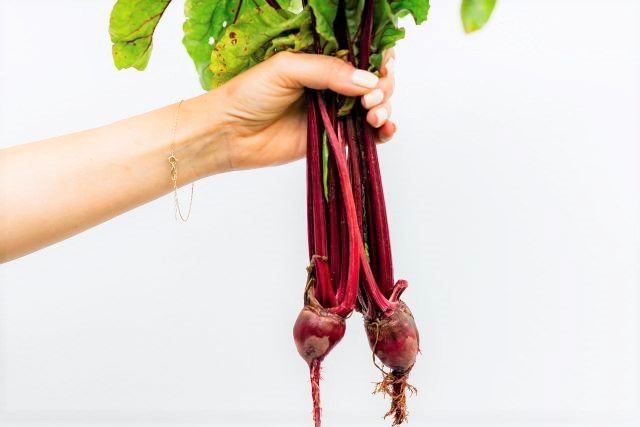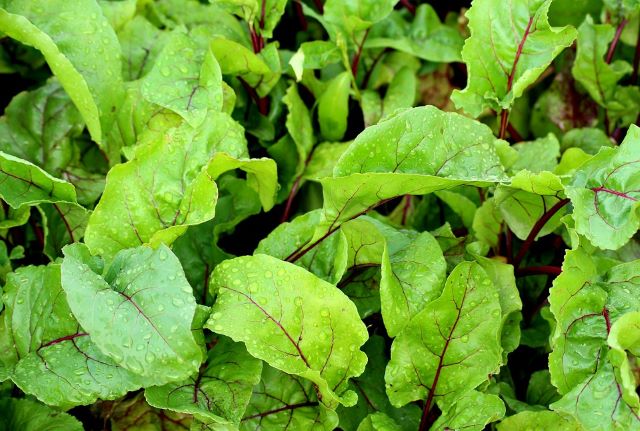Beets are a delicious root vegetable, whether pickled, cooked whole or chopped up. While the leaves of beets can be eaten, what you really want are those delicious roots. So if your beets are small and aren’t growing very big, you’ll want to know why.

Luckily, most of the time when beets are small, the problem can be fixed. In this post, I’ll look at reasons why beets might be small, and what to do about it. Let’s get into it!
Beets can be small because of poor soil conditions, watering issues, or nutrient problems. Soil pH, sunlight levels, pests and diseases, and temperature can also play a role.
Table of Contents
- Poor Soil Conditions Cause Small Beets
- Watering Issues Cause Small Beetroots
- Growing in Crowded Conditions Cause Small Beets
- Soil Nutrient Problems Cause Small Beets
- The Wrong Soil pH Cause Small Beets
- Lack of Sunlight Cause Small Beets
- Incorrect Temperature Cause Small Beets
- When to Pick Beets
- Beetroot Pests and Diseases that Cause Small Beets
Poor Soil Conditions Cause Small Beets
As a root plant, beets need light, sandy soil. If the soil is too dense, full of clay or rocks, or too heavy, the roots will have a tough time pushing through and growing to a good size.
So if your beets are in more dense soil, you’re going to want to change that. You can buy good garden soil at most hardware stores, and mix it into your soil.
If your soil is really full of clay, like mine was, your best bet is going to be raised beds. This gives the beets more room to grow their roots and allows you to more easily add good soil. So consider trying out raised beds to grow your beets.
Watering Issues Cause Small Beetroots
Since beet soil should be light, that also means it should be well-draining. Beets don’t like to sit in excess water. Luckily, a proper soil mixture should already drain well.
Still, be careful not to overwater your beets. Don’t let the soil get soggy. Wait until the top inch or so dries out, then water again. Consistent watering, and not giving too much, will keep your beets happy.
If you’re growing beets in pots, make sure that they have good drainage holes, so the excess water isn’t just sitting there and causing problems for the beets.
Growing in Crowded Conditions Cause Small Beets

If beets aren’t given enough space to grow, they can predictably come out smaller than you want. If they’re all crowded upon each other, they’re going to fight for space.
Beet seedlings should ideally be thinned to two or three inches apart, in rows that are twelve inches apart. This will give them enough room to grow. If your beets are still coming out small, you can try spacing them out a little bit more.
Also, keep in mind that one beet seed can produce multiple plants, so after you plant them, you are almost definitely going to have to thin them out.
Crowd Growing Beets
Now before we move on, you might be interested to know there is a technique of crowd growing vegetables such as beets. This is where beet seedlings are not thinned out and instead allowed to grow in crowded groups together.
Using the crowd growing technique will mean some beets will be smaller while others will grow larger. The idea here is that you harvest the largest beets first, then allow the smaller beets to continue growing in the ground and becoming larger.
This technique means you can sow more beet seeds at once and harvest a few times during the growing season.
Soil Nutrient Problems Cause Small Beets
There are two main nutrient problems that can cause beets to be small: too much nitrogen and too little phosphorus.
If beetroots have too much nitrogen, their leaves will grow very big, as nitrogen promotes leaf growth. However, this means more energy is being put into growing foliage, and less into the roots. As a result, the beets will be smaller.
To get rid of excess nitrogen, you can try giving a good watering to wash it out of the soil. You can also add organic sawdust or woodchips on top of the soil to help draw out the extra nitrogen.
On the other hand, too little phosphorus can also cause growth problems. Phosphorus aids plants in developing roots and flowers. Without it, beets won’t be able to grow as large.
Adding more phosphorus to the soil is easy: simply add an organic bone meal, like this one. Your beets should be growing better in no time!
While there are signs of nutrient problems, the only way to be sure that that’s what you’re facing is to use a soil test kit. Testing the soil will tell you what your nutrient levels are, so you know if you need to remedy anything to help your beets grow larger.
The Wrong Soil pH Cause Small Beets
Similar to nutrient problems, an imbalanced pH can also cause beets to be small. Beets prefer a pH between 6.5 and 7. If it goes higher than this (basic) or lower (acidic), it can cause problems for beetroot growth.
Again, the only way to accurately measure pH is with a test kit. This soil test kit will also test pH, on top of nutrients in the soil.
If the soil is too acidic (a low pH), you can remedy it by adding some garden lime. This isn’t the delicious fruit — it’s the mineral and will help correct the acidity of beet soil.
On the other hand, if the pH is too high, you have two options. For a quick fix, you can add a 1-1 mix of brewed coffee and water. This will help in the short term, but the effects will fade. For a long-term solution, add organic sulfur to the soil. It can take up to 6 months to work but will be more effective in the long run.
So, whether your soil pH is too high or too low, there are ways to remedy it. And then your beets will be back to growing big and healthy.
Lack of Sunlight Cause Small Beets
Beets need at least 6 hours of full sun every day. They don’t like being in the shade, whether that’s from a building or from other plants. So if your beets are small, make sure they’re getting enough sun.
If they aren’t in a very sunny location, consider moving them somewhere that gets more light. Also don’t plant them near other plants that could overshadow them without giving them adequate space. With enough sunlight, beetroots will grow nice and big.
Incorrect Temperature Cause Small Beets
Beets are more of a cold plant than many other garden vegetables. Their ideal temperature range is between 50-65°F (10-18°C). While they can tolerate temperatures a little bit higher or lower than this, they won’t grow very well once it gets away from this range.
Because of this, it’s best to sow beets 30 days before the last frost. This gives them time to grow before the temperature gets too hot. Once it gets hot, they will tend to go through their life cycle faster, meaning the roots won’t have enough time to grow to the size you want.
It’s also a good idea to stagger batches of beets across two to four weeks, so you can have a more continual harvest. But again, make sure you start early enough, so your beets aren’t exposed to very high temperatures.
If you’re in a region that makes this difficult, you can always start the beet seedlings indoors using grow lights. It’s best to do this in biodegradable containers because they don’t handle transplanting very well.
When to Pick Beets

Sometimes, if beetroots are too small, the problem might simply be that you harvested them too early! Beets take 70 to 85 days to reach maturity, so keep that in mind.
Beets are ready to be harvested when they are a few inches in diameter. Often, the top of the bulb will stick out of the soil by one to three inches. When you see this, it’s a good sign that they’re ready to harvest.
If you’re not sure if your beets are ready, dig gently in the soil around them to see how wide the bulb is. If it isn’t a few inches wide yet, they’re not ready to be harvested! Picking them too early will lead to small beets, which you obviously don’t want.
Beetroot Pests and Diseases that Cause Small Beets
Lastly, pests and diseases can cause beetroots to be small. They stress the plants, which in turn can lead to less growth. Here are some of the most common ones to watch out for.
Aphids love feeding on plants, and beets are no different. If you notice stunted growth or holes in the leaves, look for tiny green, yellow, or brown insects. They can also leave behind a sweet substance known as honeydew that you should look out for. To get rid of aphids, try washing off plants, or spraying with a mixture of neem oil or orange oil and water.
Downy mildew is a mold disease that can cause beets to be small. It will also cause gray mold to appear on the leaves, as well as light green spots. You can try treating it with an organic biofungicide, or remove infected plants. Also, be careful not to overwater the plants.
Finally, root rot can be a problem. This is often caused by excess moisture from overwatering. Is a fungal disease that will weaken and rot the roots of your beets, eventually killing the whole plant. Sadly, since the roots are the part you want, it can be devastating quickly.
Root rot isn’t usually treatable once it’s taken hold. You can try an organic biofungicide, but the best option is to remove the infected plant and replace the soil, as the fungus can live in it. And to prevent root rot, don’t overwater, and make sure your beets have well-draining soil.
Related reading:
- How to Grow Beets: Planting, Growing and Harvesting Beetroot
- Beet Leaves Turning Yellow? Causes and Solutions
- Why Are My Beets Dying? Causes and Solutions
- 13 Beet Pests Eating Your Crop (With Organic Solutions)
- Eating Beet Greens With Recipe Ideas
- How to Grow Radishes: the Easiest Vegetable to Grow
- Why Are My Garlic Bulbs So Small? Answered!
- Are Carrots a Fruit or a Vegetable? Answered!
- Why Is My Corn So Small? Causes and Solutions
